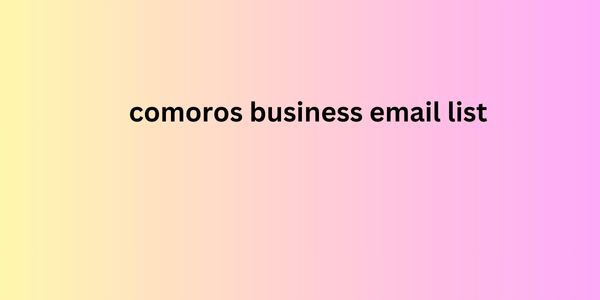This article focuses on how your business can effectively execute B2B or business-to-business content marketing; what it is, and why it is an important area comoros business email list for your business to have efficient marketing strategies in place.
What is B2B marketing
B2B marketing can be a challenging area to excel in, with so many businesses competing for the same goals, partnerships and customers.
Business-to-business marketing refers to the marketing of products or services to other businesses and organizations, as opposed to B2C marketing that focuses on marketing to consumers.

Ultimately, B2B marketing content is generally more informational and straightforward than B2C, as corporate decision-makers are more concerned with how these business decisions will affect their ROI, finances and future growth.
The aim is to expand your business’ audience whilst developing brand affinity and driving sales by appealing to other businesses who have a need for your product or service.
There are many different types of B2B marketing that your business can use, the majority of which are similar to B2C marketing tactics, only the way you create your content is very different.
The main types and channels are:
Blogs
Updating blogs regularly can create more traffic for your website and keep your audience interested, as long as the topics and forms of blogs you create stay relevant and shareable.
Social Media
There are so many social media channels out there for you to reach your audience. B2B marketing generally has a LinkedIn focus, but there is no reason you cannot utilize other platforms to research and engage with your customers as much as possible.
Many businesses utilize email marketing for lead generation and relationship management. This tactic keeps your brand top-of-mind while also enhancing the lead nurturing process; bringing efficiency, meaning to content and actionable results.
Videos
You can upload and share videos using all of the above formats. This medium is a great way to engage your audience and present the features of your business in an in-depth fashion.
SEO
By ensuring your site contains the right keywords for your audience, you will be able to rise up in the search engine ranks and create higher website traffic.
As long as your content produced in these formats is aimed at enticing businesses rather than appealing to your usual customers, these channels and techniques can be a great way of promoting your brand to other businesses.
The best approaches for creating a B2B marketing strategy
With so many approaches to B2B marketing available today, it can be difficult to decipher which is the best of the lot.
But there is no one size fits all way of tackling this problem, there are many different ways your business can utilize B2B marketing to attract other organizations to your services.
So, we are going to outline a few different approaches adopted by the best that you can tailor to the needs and functions of your business.
Approach 1
Develop an encompassing vision for your strategy and define your market:
Outline specific and achievable business goals.
Create a B2B marketing strategy around these goals, so that your primary focus is on ticking them off.
Constantly check that your audience is engaged and that sales and marketing are on the same track.
Can you actually measure the results of each of your goals?
Your audience should be much narrower than that of B2C businesses; conduct research to identify your ideal customers.
Identify possible channel types to run your campaigns:
Decide how you will reach your target audience and ensure you know features about your ideal customers.
Understand how your audience is spending time online, which social media channels they use the most and how you can offer them products and services that your competitors cannot.
Ensure your campaigns advertise the right message; include calls to action and sophisticated language, as the businesses you are appealing to will have a prior understanding of your product or service when it comes to B2B marketing.
Measure results, make adjustments, and go again:
Understand why some content works better than others so that you can make future investments in your strategy wisely.
The audience is key; use analytics tools to determine where consumers are engaging the most, what channels they are using and focus on these areas in the future.
